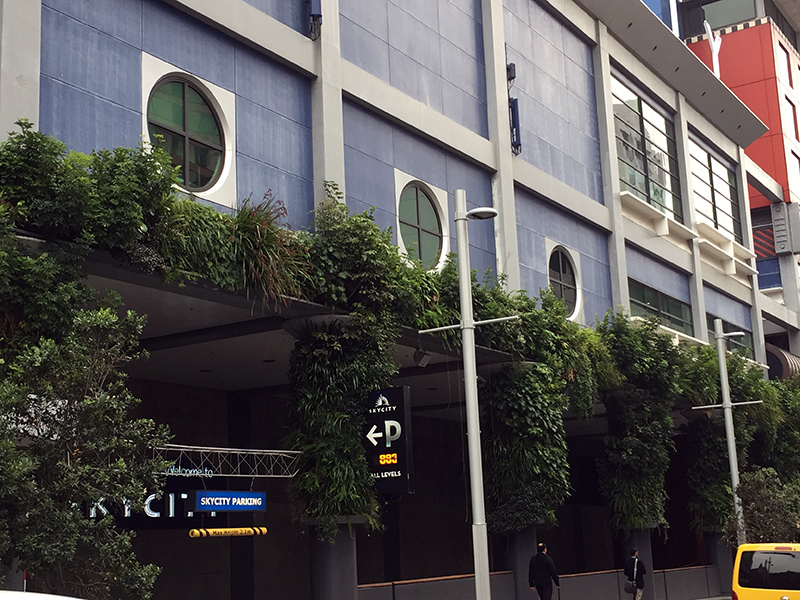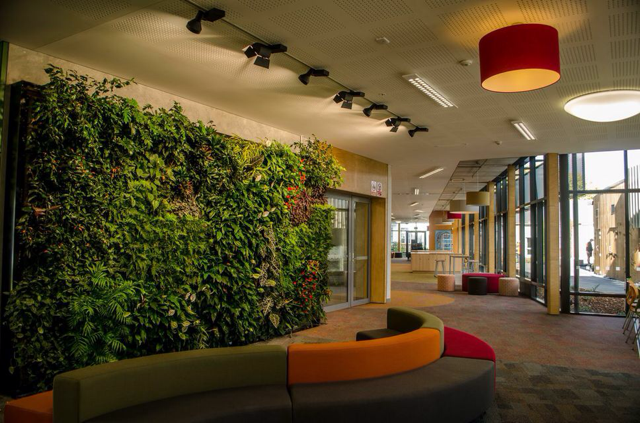While most biodiversity work is in species recovery or restoring rural habitats, at GreenAir we are trying to bring nature back to New Zealand’s cities and offices.
I grew up in the Waitakere Ranges, West of Auckland. The Ranges are all that remains of what was once a huge volcano. Its slopes are now covered in subtropical rainforest with 16,000 hectares of native bush and coastline protected as parkland.
I grew up surrounded by that forest and became passionate about plants, their potential and how important they are for us as people. I founded the GreenAir business based on that belief.
At GreenAir we work with businesses, architects and landscape designers, across New Zealand, to bring nature alive in a wide variety of sites and settings. The starting point in the designs we create for clients like Icebreaker, Lion, Les Mills, Vodafone and Fonterra is the environment.
Our Clients are seeking a living component to their commercial interiors and outside areas. Our role is to understand the way light, wind and temperature work together, on each specific site, and design the optimum installation so the plants will thrive.

Federal Street Installation
Not every installation can rely entirely on New Zealand native plant species, however native species are key to our design approach. On Federal Street, the combination of wind, shade and vertical growing surfaces meant we could select native species as 80% of the 3,500 plants. The Federal Street project – for Sky City, Auckland Council and Auckland Transport – included the first cylindrical green walls in the Southern Hemisphere, surrounding seven pillars. Some of the pillars are exposed to the Southerly wind at one end of the street and have limited direct sunlight. We needed to be sure the plants we chose would thrive in this location and that hardier species would protect more vulnerable ones.
At 48m long and 130 square metres area in total, the green walls surrounding the pillars were a large undertaking, requiring very careful planning. We undertook a substantial research and development phase as part of the project. This included growing trials before we made any final decisions about plant species selection and arrangement. The final green wall installation combined New Zealand natives, including climbing rata (Metrosideros perforate), Asplenium Obtusatum, Microsorum Scandens and Astelias.
We created the seven columns, in the heart of downtown Auckland, to remind people of the plants that grow up tree trunks in the bush. The towers don’t just look like tree trunks – we designed them to work like tree trunks ecologically too. The top of the columns are colonised by larger growing species that cover the column tops, and extend to the horizontal green wall above. As they have become established, these species are now working like a tree canopy, with the plantings below reflecting natural epiphytic ecologies, with top, middle and lower canopy species, all arranged to suit light and wind exposure and the thickness, angle and length of the plants around them.
As Ludo Campbell-Reid, Design Champion at Auckland Council said, “The Federal Street green walls by GreenAir incorporate ecology and biodiversity principles and enhance the city’s environmental sustainability. They also give city workers and visitors something unique – the experience of our native forests where you’d least expect them – right in the heart of the city centre.”
At GreenAir we’re always looking at how our projects can feature New Zealand’s unique flora, rather than replicating the species mix used in designs overseas. New Zealand plant species have adapted over thousands of years to suit our conditions. The more of them we can bring back to urban areas the better it is for sustainable plant species populations as well as native insects and birds. It’s good for people too.
Connecting people with the natural world is often a key driver for our clients. It’s part and parcel of the Icebreaker brand. This ethos drove the design for the new Icebreaker global office to bring nature inside; it was essential to Icebreaker their people experienced nature even when working indoors.
We worked closely with the architects for the project, Jasmax, and used controlled growing trials to create a solution that incorporates a wide range of plant species. We used trailing foliage to soften some of the sharper lines in the building and add life and visual interest. A green bridge gives the feeling of a pathway through a forest, using ferns and low growing ground cover. The result brings nature right inside and creates more energy in the workplace.
Significant scientific research shows how plants benefit people. Studies repeatedly show people in workplaces with plants experience better health and improved productivity. Indoor plants have been found to increase employee productivity by up to 15% (Journal of Experimental Psychology: Applied.) The field experiments by researchers at Cardiff, Exeter, Groningen, and Haslam Universities also showed improved subjective perceptions of air quality, concentration, and workplace satisfaction where plants are present in workplaces.
As Judith Heerwagen, PhD, of the US General Services Administration writes, “The cumulative body of evidence…on the people-nature relationship provides an unequivocal answer: contact with vegetation, in a variety of circumstances, is highly beneficial to human health and well being.”

Glen Eden Installation
Controlled tests have also repeatedly shown plants are effective at removing from the air chemicals including formaldehyde, zylene and benzene, often released from building materials and furnishings. In Heerwagen’s studies, coughs reduced by 37%, fatigue reduced by 30%, and dry or flushed skin was reduced by 23% with plants in the workspace.
It’s not just inside spaces that are healthier with more plants. Outside, on city streets, external green walls like the one we designed and built in Glen Eden, are helping improve air quality.
With local and World Health Organisation reports showing residents in New Zealand’s largest cities experience similar levels of particulate and nitrogen dioxide levels to people in polluted international cities, improving urban air quality is increasingly important in preventing respiratory and heart disease.
Auckland Council estimates the social cost of poor air quality in Auckland alone to be over $1billion dollars. Studies show careful placement of plants between city centre buildings can reduce street-level concentrations of nitrogen dioxide by as much as 40% and particulates by up to 60%.

Rangi Ruru School
These health and environmental impacts of plants remind us humans are part of nature, rather than separate to it, even when we are at work. The potential for plant installations to highlight this is shown really well by our project at Rangi Ruru Girls’ School in Christchurch. With the support of Fuji Xerox, the rebuilt science facilities at the school include a GreenAir designed, installed and maintained living wall that is a learning tool for students. Created to evolve over time and change with the seasons, the green wall is woven into science lessons. The behaviour and growth of the wall is monitored and the impact on temperature evaluated by the pupils. This interaction highlights the essential role plants play for humans in our habitats, as well as their part in returning biodiversity to our cities.



Leave a comment